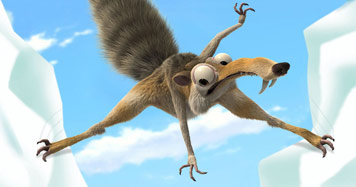
Scrat from Ice Age 2: The Meltdown. Twentieth Century Fox, ©2006.
When I was a child, back in the pre-Playstation dark ages, entertainment was rather a simple affair. TV meant network TV — no cable, no satellite, no dishes on the roof — and cartoons were what you watched on Saturday morning: Underdog, Huckleberry Hound, Tom and Jerry, Josie and the Pussycats. Of these, nothing was so rivetting as Road Runner, the Speedy Gonzales of the animal set, a creature whose superpower (supersonic speed) was comically offset by his interminable run of bad luck. My most enduring memory as a child is of sitting watching Road Runner while my mother gently (and constantly) reminded me that in real life, you don't actually bounce back to normal after a 10-ton anvil falls on your head.
Naturally, my children think this is ludicrous. They've grown up with Jimmy Neutron and Billy and Mandy, and, well, far be it from me to remind them that there's no proof that the Grim Reaper has a Jamaican accent. (Though I do, indeed, try.) As for warning them of real-life dangers, it seems that Pixar and Animal Logic have pretty much taken care of that. They've mastered a particularly persuasive (and as it turns out, rather literal) form of spin that makes Road Runner look about as scary as dryer lint.
It's the Hollwood half-pipe. And kids can't get enough of it.
We first saw it back in the Ice Age movies, where the impish Scrat careens in snowy spirals hoping to hang onto a single acorn. We saw it underwater in Finding Nemo, where sea creatures big and small engage in a bubbly ballet of loops and spins. And in the recent Animal Logic release, Happy Feet, it's pretty much taken over the whole film. Here it's a slapstick move: the loop-de-loop of the classic half-pipe plays out on a slick surface of snow and ice, the dancers waddle and flip (I should mention that they're penguins) and as the perils increase, the dance numbers do, too. Critics have praised Happy Feet's incongruous plotlines, a welcome deviation from the formulaic storylines of most cartoon movies and one which is amplified by an eclectic soundtrack clearly intended to keep parents awake. There are some inspired casting choices, like Robin Williams channeling his inner Charo and a fat-cat evangelical penguin, also voiced by Williams in a pitch-perfect rendition of Barry White. Ethnic diversity aside, the common language here is the half-pipe: they all do it, and they do it constantly, so that by the end of the film, the encroaching evil-doers seem somehow disabused of their menacing intent because the audience knows better. Ergo, the penguins slip-slide right on past the big, bad industrialists to their flap-happy, G-rated and triumphant end.
Animals have long been the protagonists of choice for children. Along the way, they've been crafted by assuming human qualities — and not just in the Western canon: from Anansi the Spider to Peter Rabbit, children thrill to the notion of a seemingly implausible character solving a problem of some visible consequence. (Obviously it is far better for little people to see a bunny in danger than to see, for example, a five-year old child held hostage by Mr. Macgregor. That's no fairy tale: that's a felony.) But in feature-length cartoons like Happy Feet, the animals assume other, more subtle and crafty qualities, too. They flirt. They fret. They exhibit passive aggressive tendencies. There are political stalemates, generational divides, economic hardships, environmental perils. In the end, there's a kind of Disney-esque resolution, suggesting that dancing is the antidote to adversity. (I'm tempted to relate this to recent events in American politics, but suffice it to say that there's a kind of loosely political "walk the walk, talk the talk" shorthand at play in this movie that's mildly discomfitting.) There's a weird mash-up going on here, and it's not just the soundtrack. Imagine channel-switching between C-Span and Dancing With the Stars. You get the idea.
Meanwhile, the film endlessly riffs on a cinematic sequence that adoringly and ineffably recalls the art of the half-pipe. Was it deliberate, this choice to recreate the graceful moves, the gravity-defying lift-off that summons images of the snow (or skate) boarder? Was it intentional, this extension of the sleek surface, from a manageable half-pipe to a menacing mountain range? (Wasn't it enough in Nemo and Ice Age? Or did somebody call market research and find out this is just — pardon the pun — the tip of the iceberg?) It is likely that there's a bankable (and at times inverse) relationship between special effects and fear: in other words, the more fun it looks, the less dangerous it will seem to viewers. (And the more concerning it will be to parents.)
I promised myself that if I had children one day, I wouldn't admonish them, as my mother did me, about the real, live dangers inspired by cartoon derring-do. But faced with the lure of the Hollywood half-pipe, I'm not so sure any more. I thought I was using good judgment opting for G over PG-13. And hey — they're cute, those penguins. But the more human they get, the less kids remember that they're birds. You don't need an anvil dropped on your head to see where this could lead. In the meantime, the animation is beautiful, if a bit vertigo-inducing. And isn't it time the cartoon-length feature veered away from water and ice, onto plain old solid ground?
